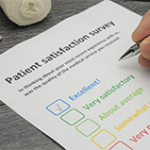Study findings also provided a way to look at all tasks and determine which were redundant. Example: The task of measuring a patient’s height was deemed redundant for every clinic visit. Height is now measured only periodically.
When the clinic staff evaluated the study data together, they each saw how their colleagues may have approached a rooming task or performed tasks in a different order. From this information, clinical staff members have worked together to learn optimal approaches for completing rooming tasks and these practices have been standardized within the electronic health record (EHR), Dr. Ramly explains.
“This additional standardization support with technology has also helped clinic staff be more consistent with rooming tasks and, thereby, reduced variation in rooming tasks and time,” he says, noting that alerts have been built into the EHR to reinforce standardized rooming with each patient.
2. Assessed Timing for New Rooming Tasks
By evaluating the variable time spent on rooming tasks and eliminating or streamlining these tasks to get to an average rooming time of six to eight minutes with less variation, Dr. Bartels and her physician colleagues established a new protocol to remeasure high blood pressures. If a patient’s blood pressure is confirmed high, an order is built into the EHR that initiates scheduling with the patient’s primary care physician for follow up. This automation helps coordinate population-level preventive care in specialty clinics, a subject her team studies.2
Another new task added to rooming is asking patients who use tobacco if they have considered cutting back or would accept tobacco cessation support. Dr. Bartels says rheumatologists sporadically addressed cessation in fewer than one in 10 visits.3
“By moving this question to a rooming task, clinical staff members who may have struggled in the past with tobacco cessation have spoken with patients from their own experiences,” she explains. “We have documented that, when consistently asked, 30% of patients intend to quit, or cut back, in the next 30 days, and we can offer help.”
3. Established a Baseline for Ongoing Quality Improvement
With the initial study data collected, Dr. Bartels, Dr. Ramly and colleagues now have a baseline to continue testing and measuring rooming time tasks, efficiency and efficacy. In this process, they have also developed a strong partnership with clinic staff members who now feel more empowered to share ideas for continually refining rooming practices.
“During the study as we observed clinic staff, we made sure to emphasize that we weren’t observing for mistakes, but rather looking to tap into their expertise and find ways to optimize the process based on their work,” Dr. Ramly acknowledges. “This early engagement proved valuable [when] study data were evaluated and rooming process changes were decided on collaboratively and implemented.”

